In the Blog
Aboriginal and Native American People: How The Media Sees Us
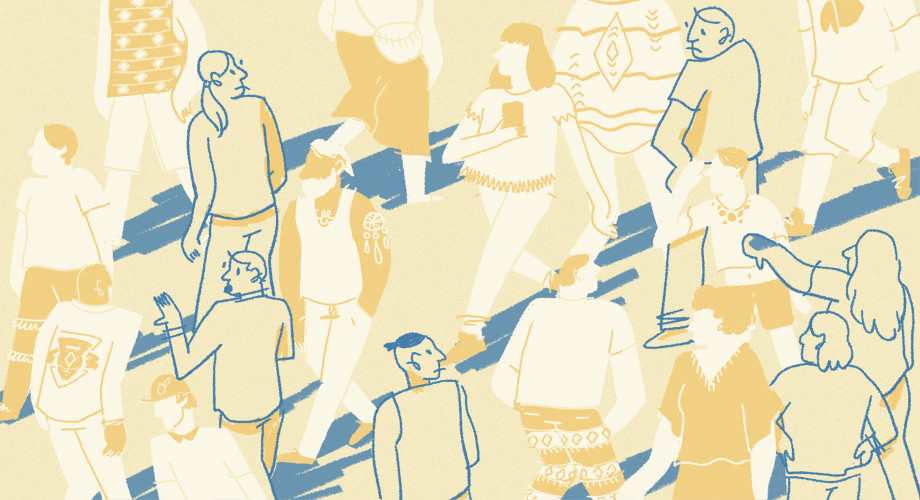
Illustration by Beena Mistry
To most people, Native people are majestic, spiritual and, sadly, a thing of the past. Most people who don’t live in America believe that Native people are all of the above, and with the representation we receive in the media - how could one not think that? And, adding to that, a lot of the media coverage we ‘receive’, half the time Native characters are not being played by actual Native people! Being a Métis woman, I did not grow up seeing myself on TV. I saw white actors, and when I did see Native characters, they were very stereotypical and racist. I didn’t realize how hurtful it was until I was much older. Native children deserve to see themselves playing on TV, they should be able to see a version of themselves being presented in a positive manner and they should not have to see “a savage Indian”, because they’re our future and if our future hates themselves for being Native, our cultures and languages will be lost.
Redface was a common occurrence throughout old Hollywood movies (along with blackface, yellowface and brownface.) If you look at The Last Of The Mohicans (1920), the main characters, who are both Native Americans in the movie, are played by two white males. Allan Roscoe as Uncas and Wallace Beery as Magua. Back in this time, white people playing people of colour in movies was quite common - however that does not excuse theedface that was displayed in this movie. Another example of edface is The Vanishing American (1925). This movie portrayed life on a Navajo reservation, but alas, the main character was yet again played by a caucasian male - Richard Dix. And I bet you’re thinking, “Wow! I’m glad Hollywood stopped using Redface in their movies!”; well, sorry to break it to you, but the most recent use of Redface was 2013. The Lone Ranger is very poor representation. Johnny Depp played Tonto, who is a Comanche companion of The Lone Ranger. Johnny Depp has claimed Native American ancestry, but has never stated which tribe, which to most Native people comes off as very fishy. Either way, the way Tonto was presented was racist and stereotypical.

Johnny Depp in The Lone Ranger
(trigger warning: derogatory terms, racial slurs)
Now we circle back to white people being castfor Native roles. Twilight (2008-2012) was one of the most popular movie series among teens during its time. It had two sides; the vampires, and the werewolves. The werewolves were a Native American tribe who had long passed down the gift of forming into a wolf. One of the main characters, Jacob Black, was a werewolf and part of this tribe. However, he was played by Taylor Lautner who is tanned with black hair; but just because people have this stereotype for Natives that we all need to be tan with long silky black hair, that doesn’t mean every tan person with black hair is Native. And that is Lautner’s case. He, like Depp, has claimed distant Native American ancestry. However, the rest of the tribe in Twilight are all Native people. This tribe is very “magical” and majestic, which leads people to believe that all Native tribes are magical and can turn into animals.
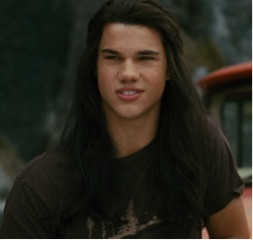
Taylor Lautner in Twilight
Peter Pan (2015) is also a prime example of non-native casting. Rooney Mara was cast to play Princess Tiger Lily (the Native rep in this movie is atrocious but we’ll save that for another time), but she’s a white female playing an originally Native American girl. Princess Tiger Lily is the daughter of Chief and (tw) Squaw. Peter Pan has always been problematic when it comes to Native Americans, however, adding onto the fact that there’s a song called ‘What Makes The Red Man Red?’, the mother is (tw) named Squaw, and Chief’s skin is literally red - they decide to cast a white female to play Princess Tiger Lily?
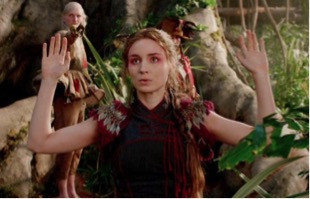
Rooney Mara in Peter Pan
Non-Native casting happens more than people realize but no one really makes a big deal out of it because a lot of people believe that Native people are extinct. And sadly, because of the representation in Hollywood, to most it looks very accurate.
Another huge problem that happens usually occurs at music festivals. Coachella is one of the largest music festivals - and it is also the place where a lot of culture appropriation happens. Now, a lot of people most likely don’t know this, but headdresses (also known as war bonnets) are very important when it comes to some (not all, since not every tribe wears headdresses) tribes. Headdresses are to be earned, they in no way are a fashion statement. Each feather on a headdress is given as an act of bravery, accomplishment or for great kindness. But this usually doesn’t matter to white or non-native people at Coachella! A lot of people disregard Native people’s concerns or disgust when it comes to them wearing headdresses for fashion statements. I personally take offense to it because I dislike seeing my culture worn as a joke or a fashion statement - and I’m sure a lot of other Native people feel the same way.
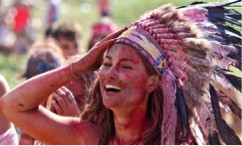
Example from a Music Festival
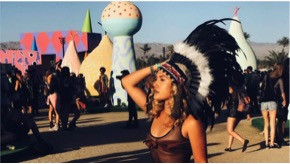
Example from a Music Festival
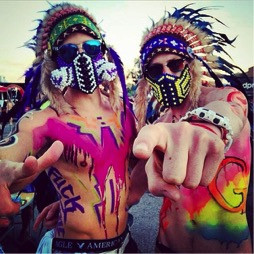
Example from a Music Festival
This next one was not at Coachella (as far as I know), but is still culture appropriation and people need to realize that wearing important things from a culture you are not a part of is very disrespectful. Here is Khloe Kardashian wearing a headdress, and nothing else.
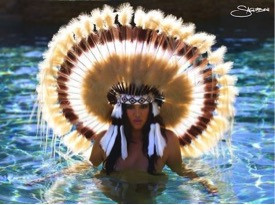
Khloe Kardashian
Native women are sexualized enough - and the fact that this photo shows a non-native woman, naked with a headdress on only adds to that constant sexualization.
Most people believe that all Native cultures are exactly the same, which, is definitely not true. There are some cultures that have one thing (ie headdresses) that others don’t. Each tribe also speaks a different language than the next, so we are in no way “all the same.” Another issue that often occurs is, when a Native person is actually casted for a Native role, they tend to be from the wrong tribe. For example, casting a Navajo woman as a Cree woman in your new up and coming movie is not very good. Yes, it is representation for Natives which is good! However, it is not representation for the tribe. When this happens, this is what usually makes people believe that all Native cultures are the same. However, this really isn’t that big of a deal - I would rather this than whitewashing or redface. Lumping cultures together in movies, comics, books etc is also a really bad thing that happens a lot. There are different prayers, warpaint, clothing, jewelry and so on in each tribe; lumping different languages or prayers together is highly inaccurate and honestly? It’s very saddening that people believe we are all the same. We each have different creation stories, we each have different histories, different experiences, different past enemies. Native people deserve to be represented properly, we shouldn’t have to ‘settle’ for incorrect representation.
I asked a couple Native people I know a few questions, and these are their answers.
CODY (CHIPPEWA):
Q: What’s your opinion on Redface?
It makes me angry, it should make anyone that’s a decent human angry. It’s just as bad as people doing blackface and yellowface…it mocks and is super offensive.
Q: How does it make you feel when a Non-Natives plays a Native character?
When a Non-Native plays a role or character that is canon or written to be Native, it is so hurtful to us all. It’s Hollywood saying we’re not good enough to play ourselves, it’s damaging for little Native kids especially, if they can’t relate to characters on screen and see themselves in those actors then that can ruin their dreams and aspirations… it’s even worse when a character is canon Native but they’ll rewrite a script to make the character white or any other race. Natives of all sizes and shades needs to see themselves represented but more so brown and black Natives. I would love to see my culture on the big screen (done right of course!) and other native cultures, we’ll get there hopefully.
Q: Do you think the Redskins should change their name?
I really hate that word, redskins; it’s disgusting and degrading. Especially seeing the pictures of fans with their faces painted in redface and wearing ugly, knockoff war bonnets… it’s so disrespectful and it isn’t “honoring” Natives in any shape or form. It’s reducing all Native cultures to one monolith that assumes we all wear headdresses instead of the handful of tribes that actually do use them. It’s very toxic and damaging for young Native kids to see this mockery. It can make them feel ashamed of themselves and that makes me so so sad. Our cultures are alive and struggling to survive, we’re not a costume or mascot…. we’re still here and these people treat us like we’re a thing of the past. We’re. Still. Here.
Q: How does it make you feel when you see Non-Natives wearing headdresses?
I absolutely want to rip the headdresses off every Non-Native I see at music festivals and such. It’s basically stolen valor… the war bonnet is earned, not bought for $15 at party dollar. Every feather is earned individually…. I also hate that everyone seems to think all tribes used war bonnets as well. Only a handful used them, other tribes had their own respective head pieces. Again, it isn’t honoring us. Our cultures are struggling to survive and we don’t need Non-Natives running around making a mockery of our cultures. We’re a culture NOT a costume. You can’t run around and “play Indian” at music festivals and then not give a shit about the people you’re “honoring.” Also the fact that these settlers are out on etsy paying $500+ for these knock offs is hilarious because they’re essentially spending money and wearing these monstrosities and everyone knows they’re jackasses…like I’m sure sane people all have the same consensus that Non-Natives wearing headdresses are all assholes.
ALEX (MI’KMAQ):
Q: What’s your opinion on Redface?
I find redface really really offensive not only because NNs are pretending to be us, but because for so long they wouldn’t allow US to be us and would murder us for that (they still do, but especially during the height of the residential school era with all the “kill the indian, save the man” business). Plus it’s always based on caricatures of us (“pocahottie” costumes) or nasty stereotypes (the typical “savage warrior” look, booze, those kinds of things). If we get killed for being us then what gives our murderers the right to pretend to be us for “fun” and then attack us for being bothered when we speak up?
Q: How does it make you feel when a Non-Native plays a Native character?
It’s disappointing because there’s so many really talented native actors that get stuck doing low budget tv documentaries while big movies or shows have NNs taking native roles (cough, unbreakable kimmy schmidt, cough). It’s not often that native kids get to see themselves in the media they watch, like, as a kid I’m pretty sure the most representation i saw was yvon of the yukon and that can really hurt young natives even if it seems like a small thing since we already get talked over so much. (Also note, it’s ironic that in kimmy schmidt they have a NN actress playing a native character in a storyline about fighting for native rights and getting rid of the redskins team name.)
Q: Should the Redskins change their name?
Yes !!! They most definitely should !!! It’s a slur just like many others that they likely wouldn’t dare to use as a team name. It doesn’t honour us, and it just makes for a convenient excuse for smaller teams to use offensive names and imagery (like port neches-groves school in texas, a mostly NN school whose team is called the indians and uses MANY offensive stereotypes about us). Just because it’s “tradition” or whatever doesn’t make it okay.
Q: How does it make you feel when you see Non-Natives wearing headdresses?
I hate it so so so much. I hardly even see actual natives wearing headdresses because it’s such a big important thing to us, so to see NNs strutting around music festivals wearing knockoff full-length war bonnets that they bought from etsy really hurts. For the native cultures that use them they’re a HUGE honour and hold so much spiritual significance, and some NNs treat them like a fashion accessory. They just cherry pick elements of our cultures to bastardize and commodify and they get to make a profit from exploiting us and our cultures.
So, all in all, Native people in media are not represented well. And I really hope that soon people will realize that, and start working towards it rather than moving backwards. Time can only tell what will happen. But one day, I really hope the younger generations of Native people will see themselves in movies or on TV shows more; everyone deserves a chance to be represented positively, so when is it our turn?



